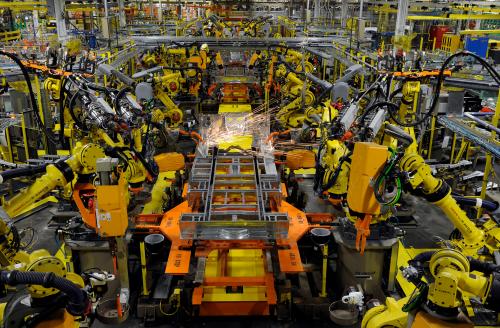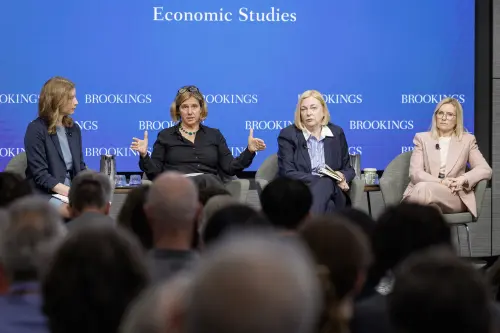There is a disruptive revolution under way in manufacturing—and the U.S. needs to stop fighting it.
For years, Washington has made increasing manufacturing employment a priority, hoping to engineer a return to the time when high-school graduates could use factory jobs as a route to the middle class. Sadly, that isn’t going to happen. Of the 5.7 million manufacturing jobs that disappeared in the 2000s, only 870,000 have returned so far, according to the Bureau of Labor Statistics, and the claim that millions more are coming back is nothing more than a myth.
The truth is, manufacturing will be crucial to the U.S. economy in the future not for its ability to create jobs but for its potential to drive innovation and productivity growth, and for its role in international trade and competitiveness. That means if the U.S. is serious about promoting a recovery in manufacturing, it will stop measuring success by the number of people employed in the sector and start supporting the technological advancements that are making factories more productive, competitive and innovative.
Seismic shift
This technological revolution may result in fewer factory jobs for low-skilled workers, but it promises to benefit society by driving growth not only in manufacturing but in the broader U.S. economy, as well. Already under way, the shift is being powered by three key technology developments.
The first is the Internet of things, in which embedded sensors transmit information from machine to machine, allowing them to work together and identify maintenance problems before a breakdown occurs. The second is advanced manufacturing, which includes 3-D printing, new materials and the “digital thread,” where companies use very accurate digital models to guide all stages of product development, speeding the time to market and improving quality. Finally, there is distributed innovation, in which crowdsourcing is used to find radical solutions to technical challenges much more quickly and cheaply than with traditional in-house research and development.
The way to promote a robust and competitive manufacturing sector is for industry leaders and policy makers to support these advances, even if it means putting robots in place of workers. There will still be good jobs in manufacturing, especially for those with big-data, programming and other specialized skills needed for advanced manufacturing.
Indeed, some managers already are having a hard time finding the talent they need to transform their organizations, which is why the U.S. should encourage highly skilled immigrants to stay in the U.S. instead of sending them home. These workers may compete with Americans for jobs, but they also launch innovative startup companies and have the technical expertise that U.S. research-and-development labs are going to need as value and profit in manufacturing shift to digital assets.
By contrast, propping up uncompetitive jobs with tax breaks and subsidies won’t work for long and only stands in the way of introducing a lower corporate tax rate that would drive new investment.
Consider that in 2014, the U.S. manufacturing sector ran a trade deficit of $524 billion. Chronic trade deficits have contributed to the sector’s job losses and required large-scale foreign borrowing that has made the U.S. a net debtor to the rest of the world to the tune of nearly $7 trillion by the end of 2014. Running up endless foreign debts is a disservice to our children and was one source of the instability that led to the financial crisis. The technology revolution could help address this problem by making it more profitable to manufacture in the U.S., using highly automated methods.
Setting policy
While the fate of the manufacturing revolution is largely in the hands of the private sector, policy makers can help speed it along and ensure the benefits are felt in the broader economy.
For starters, new trade agreements can make U.S. manufacturing stronger by reducing foreign barriers to U.S. goods, while having only a minimal impact on imports since tariffs and trade barriers in the U.S. already are very low.
Of course, prioritizing competitiveness, innovation and the U.S. trade position over jobs can be politically difficult, so it is important that policy makers also look for ways to help displaced workers and hard-hit communities. If displaced factory workers end up as long-term unemployed, or in dead-end, low-wage jobs, then the manufacturing revolution’s benefits to society are lost.
Government training programs have a weak track record, but if businesses do the training or partner with community colleges, the outcomes typically are better. Training vouchers and wage insurance also can help former factory workers find new careers. Good jobs exist in the service sector for those with the right training. Examples include plumbers, electricians, auto mechanics and medical technicians.
The government also should do what it can to nurture the ecosystems that exist around large manufacturers because as these big companies transition to new ways of manufacturing, they may have to rely on small local firms to provide the skills and technologies they don’t have in-house. The problem is, many smaller manufacturing firms went out of business from 2000 to 2010 as the sector downsized.
Clearly, the private sector has the biggest stake in developing the ecosystems they need, but government can help, and has helped, particularly at the state and local level, by making needed infrastructure investments, providing funding, joining with business groups to create mentoring program for young firms, and establishing simplified and expedited permitting processes that make it easier for small businesses to operate.
It is hard to let go of old ways of thinking, but continuing to chase yesterday’s goals only puts off the inevitable. Instead of dragging out the fight for more manufacturing jobs, we need to focus on speeding up the manufacturing revolution, funding basic science and engineering, and ensuring that tech talent and best practice companies want to produce in the U.S.
The Brookings Institution is committed to quality, independence, and impact.
We are supported by a diverse array of funders. In line with our values and policies, each Brookings publication represents the sole views of its author(s).









Commentary
Op-edHow the U.S. gets manufacturing policy all wrong
June 2, 2015